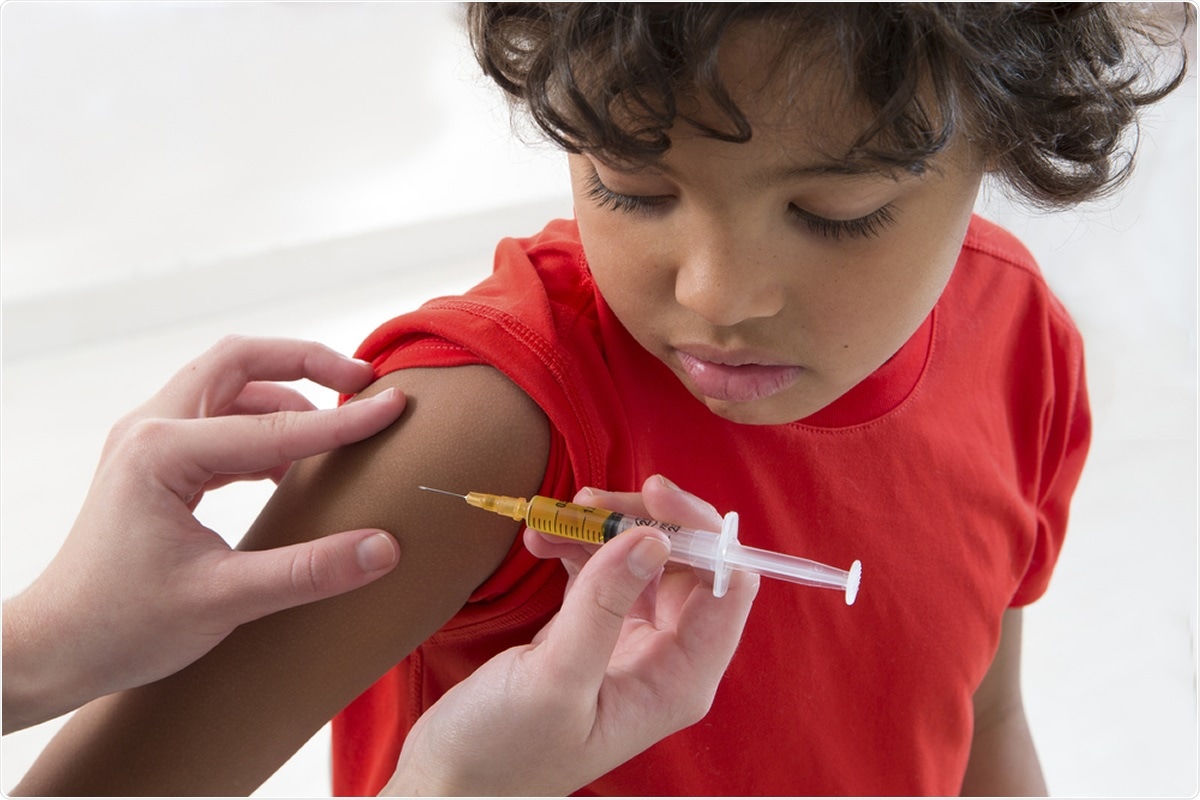Should a COVID-19 vaccine be mandatory for children?
by Dr. Liji Thomas, MDAs the search for a severe acute respiratory syndrome coronavirus 2 (SARS-CoV-2) vaccine continues, with some candidate vaccines nearing the completion Phase III clinical trials, a trio of experts weighs in with some sound reasoning as to whether any future vaccine should be considered mandatory for children. The viewpoint article is published in the journal JAMA Pediatrics in September 2020.
The effort to create an effective vaccine against SARS-CoV-2 has been exceptional, with enormous backing by the presidential initiative Operation Warp Speed, which is focused on producing hundreds of millions of doses by the beginning of 2021. Thousands of adult volunteers are registered for participation in vaccine trials as they approach that stage. Also millions of adults in the US have already made plans to get vaccinated as soon as it is available.

Viewpoint - Should We Mandate a COVID-19 Vaccine for Children? Image Credit: JPC-PROD / Shutterstock
How COVID-19 Vaccines Compare with Other Vaccines
The question already being discussed in some quarters is whether a COVID-19 vaccine should be made mandatory – especially for children, for whom several vaccines are already compulsory for school enrolment. With the current pandemic situation, it is entirely possible that school reopenings or keeping schools open may be made dependent on whether the student has been vaccinated against the virus.
A commonly drawn analogy is that between SARS-CoV-2 and the influenza vaccine. As of now, the latter is not mandatory for school attendance, though it is, like the former, a respiratory virus transmitted mostly by respiratory droplets. However, a noticeable difference is that children are closely involved in the spread of influenza, which is a killer for elderly and weakened patients. This has not been proved to be so for COVID-19, which makes for a weak argument for mandatory vaccination in children.
Secondly, the SARS-CoV-2 spreads more widely than the flu virus, with the reproduction number R0 being ~1 and 2-2.5 for these viruses, respectively. With a higher R0, the proportion of people needed to prevent transmission is higher. Above a certain level, this can be achieved only by vaccination, as shown by the measles vaccine. Here, with an R0 of 12-18, two doses of vaccine have achieved and maintained herd immunity at 92% to 94% immunity.
Criteria for Mandatory COVID-19 Vaccine in Children
The most efficient way is to use the nine standard criteria for deciding whether or not a COVID-19 vaccine should be mandated for children. These are vaccine-related, disease-related, and implementation-related, with 4, 2, and 3 in each of these groups. These include:
- Vaccine safety
- Vaccine efficacy
- Vaccine cost-effectiveness
- A vaccine increases safety at school
- The disease prevented has significant morbidity or mortality in one or more population segments
- Individual transmission can be prevented by the vaccine when given to infants, adults, or adolescents
- Vaccine acceptability
- Vaccine logistics are reasonable
- Vaccination schedule adherence is not burdensome for parent or caregiver
Using the Criteria
The authors propose weighting five criteria even while using all nine to make a decision. The foremost is safety, which must be ensured to keep public trust in mandatory vaccination high. This remains so even if, in an emergency situation, voluntary or emergency use may be allowed without full safety data. For a mandatory pediatric vaccine, safety data must be available both before and after licensing, so as to pick up adverse effects.
The other four top criteria include the fifth, sixth, second, and ninth. The second is already applicable since COVID-19 poses a significant disease burden. The sixth is still in the balance since there is no clear proof that children do play a role in the individual transmission of COVID-19. The effectiveness of the vaccine to prevent pediatric COVID-19 is still unclear if compared with other vaccines already in use.
And finally, the primary reason for the vaccine is to protect adults at high-risk rather than the vaccine recipients themselves, which implies that it should be easy to comply with mandatory vaccination and that the latter should be widely available, easily obtained, and inexpensive.
Implications
As different aspects of COVID-19 become more evident, one criterion might overtake another. For instance, if more cases of multisystem inflammatory syndrome (MIS-C) crop up in children, this would indicate a greater risk of harm to children themselves. This would mean that this would then take priority over reducing viral spread or the ease of compliance in deciding whether the vaccine should be made mandatory in children.
On the other hand, they say, if children are little affected, the last criterion will be more important. Thus, these criteria should become part of the framework for routine evaluation of whether it is necessary to mandate such a vaccine.
Journal reference:
- Opel, D. J. et al. (2020). Should We Mandate a COVID-19 Vaccine for Children? JAMA Pediatrics. doi:10.1001/jamapediatrics.2020.3019. https://jamanetwork.com/journals/jamapediatrics/fullarticle/10.1001/jamapediatrics.2020.3595